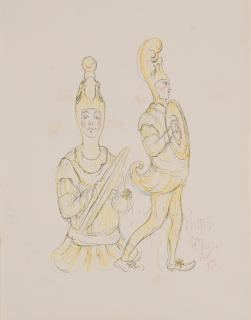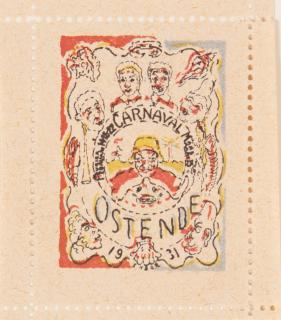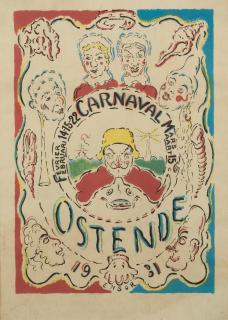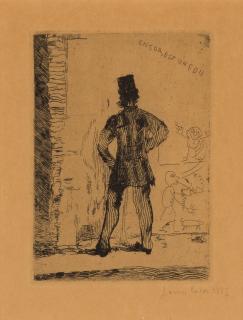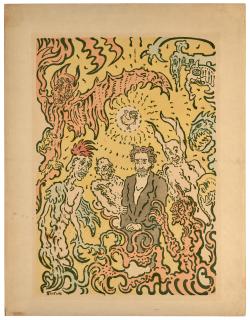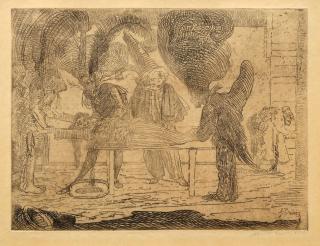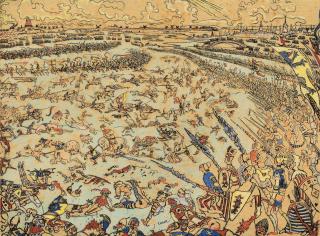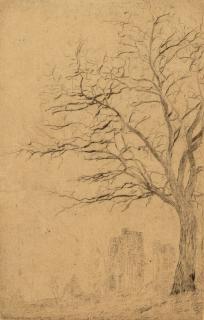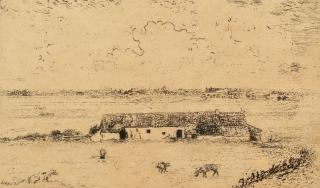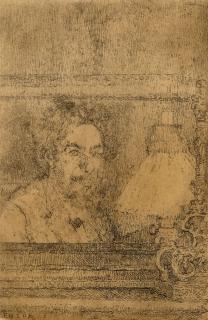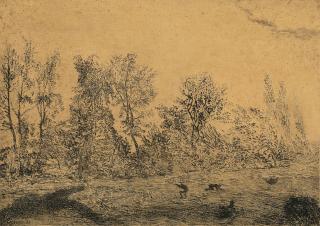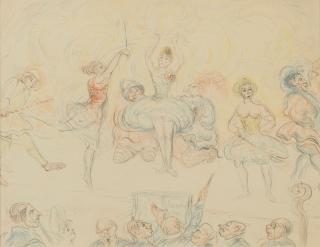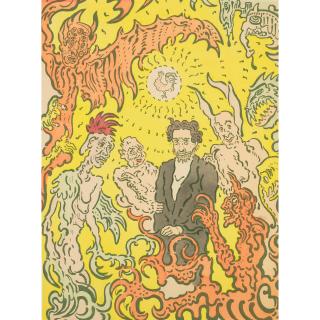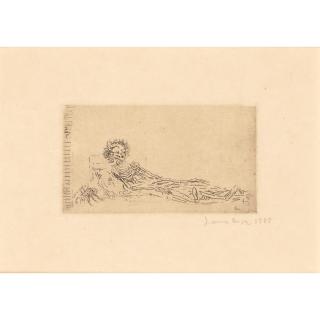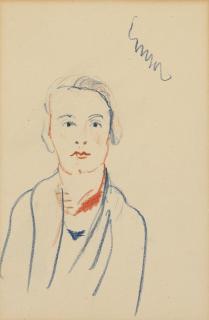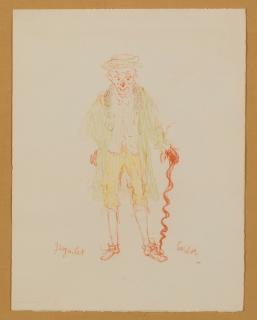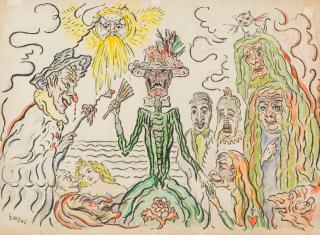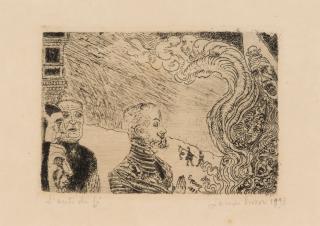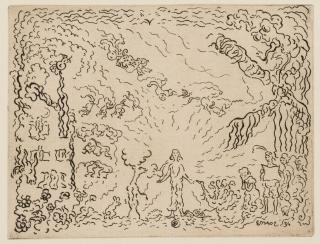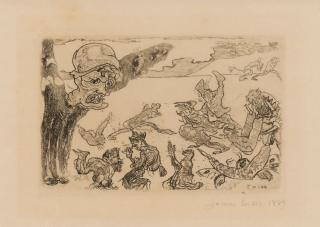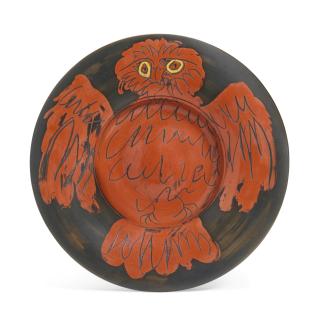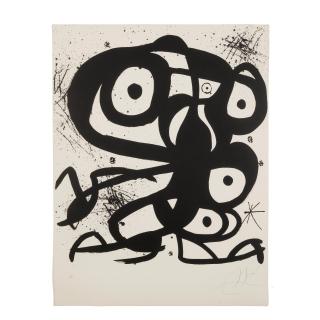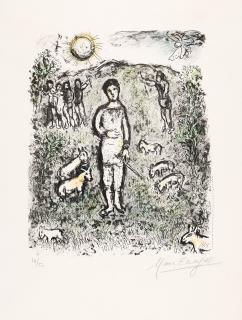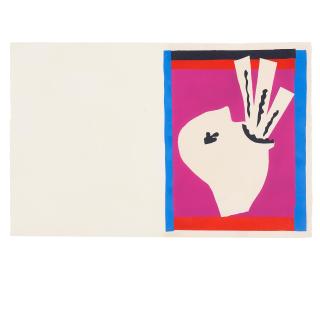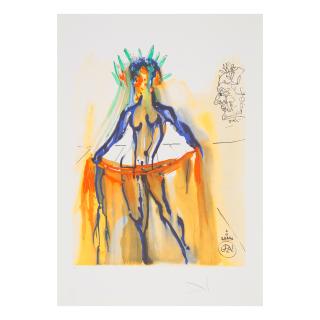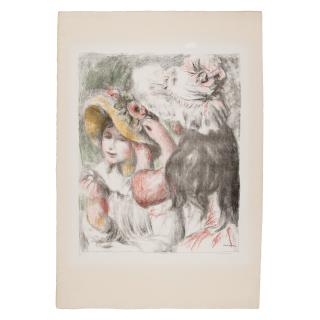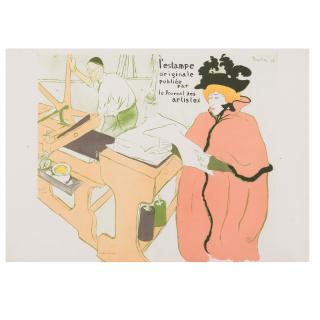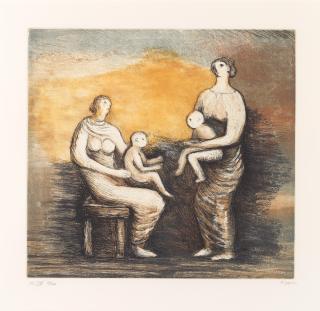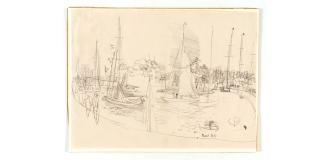James Ensor 1860 - 1949
The artist James Ensor
- Belgian painter of Symbolism.
- Became known as the »painter of masks«.
- In his late creative phase, he oriented himself towards the style of Expressionism.
James Sidney Ensor, born 13 April 1860 in Ostend, Belgium, deceased 19 November 1949 in Ostend, Belgium, was a Belgian Symbolist painter, draughtsman, etcher and caricaturist.
Ensor is primarily assigned to Symbolism, although his late work in particular was more oriented towards the style of Expressionism - in some cases he is also understood as a precursor of Expressionism. Ensor made his extensive depictions of masks his hallmark.
Some of his masks, together with his likeness, were later to adorn the last Belgian 100-franc note before the introduction of the euro – thus he went down in art history as the »painter of masks«. His pictorial language can be described as dreamlike, fantastic and partly demonic – death repeatedly played a central role in his paintings. Thus, in addition to the masks, the skeleton also served as a recurring motif for him.
Ensor first completed an apprenticeship as a painter and then attended the Academy of Fine Arts in Ostend from 1876. Just one year later, he began studying at the Academy of Fine Arts in Brussels – he left the academy without a degree, however, because he was bored with the master's apprenticeship and could not exploit his creativity in this way. Ensor first worked as an etcher, caricaturist and draughtsman before devoting himself entirely to painting.
Although Ensor's first solo exhibition took place as early as 1881, he did not become accessible to a wider public until the late 1920s – when he was given exhibitions in various German cities as well as in Paris. In 1929 he was made a Baron by King Albert I. Ensor died in 1949 at the age of 89 in Ostend, which he had never left except for the short period of his studies in Brussels.
Der Künstler James Ensor
- Belgischer Maler des Symbolismus.
- Wurde als »Maler der Masken« bekannt.
- Orientierte sich in seiner späten Schaffensphase am Stil des Expressionismus.
James Sidney Ensor, geb. 13.04.1860 in Ostende, Belgien, gest. 19.11.1949 ebenda, war ein belgischer Maler, Zeichner, Radierer und Karikaturist des Symbolismus. Ensor wird vorrangig dem Symbolismus zugeordnet, wenngleich sich insbesondere sein Spätwerk mehr am Stil des Expressionismus orientierte – in einigen Fällen wird er auch als Vorläufer des Expressionismus verstanden. Ensor machte sich seine umfangreichen Darstellungen von Masken zum Kennzeichen.
Einige seiner Masken sollten später zusammen mit seinem Konterfei die letzte belgische 100-Franken-Note vor der Euroeinführung zieren – so ging er als »Maler der Masken« in die Kunstgeschichte ein. Seine Bildsprache ist als traumartig, fantastisch und teils dämonenhaft zu beschreiben – der Tod spielte immer wieder eine zentrale Rolle in seinen Gemälden. So diente ihm neben den Masken auch das Skelett als wiederkehrendes Motiv.
Ensor absolvierte zunächst eine Malerlehre und besuchte anschließend ab 1876 die Akademie der Schönen Künste in Ostende. Bereits ein Jahr später nahm er dann ein Studium an der Kunstakademie in Brüssel auf – er verließ die Akademie allerdings ohne Abschluss, weil ihn die Meisterlehre langweilte und er seine Kreativität auf diese Weise nicht ausschöpfen konnte. Ensor war zunächst als Radierer, Karikaturist und Zeichner tätig, bevor er sich gänzlich der Malerei widmete.
Ensors erste Einzelausstellung fand zwar bereits 1881 statt, einer breiteren Masse wurde er aber erst Ende der 1920er-Jahre zugänglich – damals wurden ihm Ausstellungen in verschiedenen deutschen Städten sowie in Paris zuteil. 1929 wurde er von König Albert I. zum Baron gekürt. Ensor starb 1949 im Alter von 89 Jahren in Ostende, das er bis auf die kurze Dauer seines Studiums in Brüssel nie verlassen hatte.
James Ensor in a nutshell
James Ensor spent almost his entire life in his native town of Ostend in Belgium, where he was born in 1860 and died in 1949. The port city, which today has a population of over 70,000, was already an important fishing and port city at the time. During the summer months, the Belgian royal family and English nobility spent time there because of the seaside resort. Ensor's father came from a wealthy English family and settled in Ostend, where he married a Belgian woman from a humble background, the artist's mother. For Ensor himself, the sea on which his hometown is located was a lifelong source of inspiration, and it had a decisive influence on his artistic work. Only when he was 17 and attended the Académie royale des Beaux-Arts de Bruxelles for two years did Ensor spend an extended period of time away from his hometown.
Regarding his childhood, as he spent much time in his mother's souvenir store, Ensor wrote the following: »I spent my childhood amidst shining pearly shells with dancing, iridescent reflections and the bizarre skeletons of sea monsters and plants. This glorious world of color, this profusion of reflections and rays, has made me a painter in love with color and enraptured by the dazzling glow of light.«
One of the defining features of James Ensor's art is its subversive nature. Ensor fearlessly challenged societal norms, conventions, and institutions through his provocative imagery. His paintings often critique religious hypocrisy, political corruption, and the masks worn by society. By exposing the dark undercurrents of human behavior, Ensor confronted his viewers with uncomfortable truths, inviting introspection and reflection.
Ensor's use of grotesque imagery adds another layer of complexity to his art. He often depicted masked figures, skeletons, and carnival scenes, blurring the line between the real and the surreal. Through these symbolic representations, he explored themes of death, mortality, and the transience of life. The grotesque elements in his works confront viewers with the paradoxical nature of existence, simultaneously repelling and fascinating them.
James Ensor's art demonstrates a mastery of technique and a keen attention to detail. His brushwork is meticulous, displaying a remarkable range of textures and effects. From delicate brushstrokes to bold and expressive gestures, Ensor's technical proficiency enhances the emotional impact of his works. His use of vibrant colors and contrasts further intensifies the visual experience, creating a sense of unease and heightened drama.
Despite facing initial rejection by the art establishment, James Ensor's art went on to influence subsequent generations of artists. His fearless exploration of unconventional themes, innovative use of symbolism, and unique visual language left an indelible mark on modern art movements such as Expressionism and Surrealism. Artists like Paul Klee and Max Ernst were inspired by Ensor's ability to merge the grotesque with social critique.
In recent years, there has been a renewed interest in James Ensor's art, leading to a rediscovery and reappraisal of his significance. His works are showcased in renowned museums and galleries worldwide, allowing new generations to experience the power and audacity of his artistic expression. Ensor's ability to challenge societal norms and reveal the darker aspects of humanity continues to resonate with contemporary audiences.
Masks are a central component of Ensor's work, as are skeletons. They are part of his socio-critical, fantastic, and caricatured work and, depending on the context, offer a variety of possible interpretations. Ensor expressed himself this way about masks: »I have cheerfully exiled myself to that solitude in which − all violence, light and splendor − the mask is enthroned. The mask means to me: freshness of tone, exaggerated expression, splendid decoration, grand, unsuspected gesture, uninhibited movement, exquisite turbulence.«
Ensor was interested in Flemish masks of his homeland, not African masks used by Expressionists and famous painters like Picasso. With skeletons Ensor used to provoke and express irony.
The painting was created in 1888/89 and measures about 250 x 430 cm. It is now considered Ensor's major work, breaking all compositional, content, and stylistic rules that applied to paintings in the 1880s. It has hung in the Getty Museum in Los Angeles since 1987. Ensor relocates Christ's Entry into Jerusalem, commemorated on Palm Sunday, to Brussels in 1889, where Belgian society gathers, wearing masks or depicted as caricatures. They stand around Ensor, who depicts himself as the Savior in the work. The painting is an expression of Ensor's commitment to social revolution, as evidenced by numerous banners with inscriptions such as Vive la Sociale, but the individual figures often appear preoccupied with themselves and inattentive. However, a unified interpretation of the complex work is still lacking today.
After the death of his mother and aunt, Ensor moved in 1917 to a small townhouse he had inherited from his uncle (now a museum: the James Ensor House). It was here that he was first able to hang the rolled-up canvas of his monumental painting Christ's Entry Into Brussels in 1889, where he showed it to visitors. After Ensor's death, Louis Franck acquired the painting and placed it on permanent loan to the Royal Museum of Fine Arts in Antwerp. It was only now, in the 1950s, that the painting made it to the public, delighting critics and the public. In 1987, the Getty Museum purchased the painting for an estimated $7 million to $8 million. A copy of the work hangs in the James Ensor House where the original was located during Ensor's lifetime.
Socially critical paintings and etchings were a major concern of the artist. However, they were too macabre in the 19th century and therefore difficult to sell. From about 1900, in the wake of free modern art, Ensor was increasingly appreciated as an avant-garde painter. Even in old age, he was committed to a just society and was ahead of his time, as can be seen, for example, in his painting The Vile Vivisectors, with which he spoke out against animal testing as early as 1925.
Häufige Fragen zu James Ensor
James Ensor verbrachte fast sein ganzes Leben in seiner Geburtsstadt Ostende in Belgien, wo er 1860 geboren wurde und 1949 verstarb. Die Hafenstadt mit heute über 70.000 Einwohnern war damals bereits eine bedeutende Fischer- und Hafenstadt mit etwa 16.000 Bewohnern. In den Sommermonaten verbrachte das belgische Königshaus und englische Adelige wegen des Seebads ihre Zeit dort. Ensors Vater entstammte einer wohlhabenden englischen Familie und ließ sich in Ostende nieder, wo er eine belgische Frau aus einfachen Verhältnissen heiratete, der Mutter des Künstlers. Für Ensor selbst war das Meer, an dem seine Heimatstadt liegt, lebenslange Inspirationsquelle und es prägte sein künstlerisches Werk maßgeblich. Einzig als er mit 17 die Académie royale des Beaux-Arts de Bruxelles für zwei Jahre besuchte, verbrachte Ensor eine längere Zeit außerhalb seiner Heimatstadt.
Zu seiner Kindheit, da er viel Zeit im Andenkenladen seiner Mutter verbrachte, schrieb Ensor folgendes: »Ich habe meine Kindheit inmitten von glänzenden perlmuttfarbenen Muscheln mit tanzenden, schillernden Reflexen und den bizarren Skeletten von Meeresungeheuern und -pflanzen verbracht. Diese herrliche Welt voll Farben, diese Überfülle von Spiegelungen und Strahlen hat aus mir einen Maler gemacht, der in die Farbe verliebt und von der blendenden Glut des Lichtes entzückt ist.«
Eines der charakteristischen Merkmale der Kunst von James Ensor ist ihr subversiver Charakter. Mit seiner provokanten Bildsprache stellt Ensor gesellschaftliche Normen, Konventionen und Institutionen furchtlos in Frage. Seine Gemälde kritisieren oft religiöse Heuchelei, politische Korruption und die Masken der Gesellschaft. Indem er die dunklen Unterströmungen des menschlichen Verhaltens aufdeckte, konfrontierte Ensor seine Betrachter mit unbequemen Wahrheiten, die zur Selbstreflexion und zum Nachdenken anregten.
Die Verwendung grotesker Bilder durch Ensor verleiht seiner Kunst eine weitere komplexe Ebene. Er stellte oft maskierte Figuren, Skelette und Karnevalsszenen dar und verwischte so die Grenze zwischen dem Realen und dem Surrealen. Durch diese symbolischen Darstellungen erkundete er Themen wie Tod, Sterblichkeit und die Vergänglichkeit des Lebens. Die grotesken Elemente in seinen Werken konfrontieren den Betrachter mit der paradoxen Natur der Existenz, die ihn gleichzeitig abstößt und fasziniert.
Ensors Kunst zeugt von einer meisterhaften Technik und einer ausgeprägten Liebe zum Detail. Seine Pinselführung ist akribisch und weist eine bemerkenswerte Bandbreite an Texturen und Effekten auf. Von zarten Pinselstrichen bis hin zu kühnen und ausdrucksstarken Gesten - Ensors technische Fähigkeiten verstärken die emotionale Wirkung seiner Werke. Seine Verwendung von leuchtenden Farben und Kontrasten intensiviert das visuelle Erlebnis und schafft ein Gefühl von Unbehagen und gesteigerter Dramatik.
Trotz der anfänglichen Ablehnung durch das Kunstestablishment hat James Ensors Kunst nachfolgende Künstlergenerationen beeinflusst. Seine unerschrockene Auseinandersetzung mit unkonventionellen Themen, sein innovativer Einsatz von Symbolik und seine einzigartige Bildsprache haben moderne Kunstströmungen wie den Expressionismus und den Surrealismus unauslöschlich geprägt. Künstler wie Paul Klee und Max Ernst ließen sich von Ensors Fähigkeit inspirieren, das Groteske mit Gesellschaftskritik zu verbinden.
In den letzten Jahren hat das Interesse an James Ensors Kunst wieder zugenommen und zu einer Wiederentdeckung und Neubewertung seiner Bedeutung geführt. Seine Werke werden in renommierten Museen und Galerien auf der ganzen Welt ausgestellt und ermöglichen es neuen Generationen, die Kraft und Kühnheit seines künstlerischen Ausdrucks zu erleben. Ensors Fähigkeit, gesellschaftliche Normen in Frage zu stellen und die dunklen Seiten der Menschheit zu enthüllen, findet auch heute noch Anklang beim Publikum.
Masken sind zentraler Bestandteil in Ensors Werk, wie auch Skelette. Sie sind Teil seiner gesellschaftskritischen, phantastischen und karikierenden Arbeit und bieten, je nach Kontext, vielfältige Deutungsmöglichkeiten. Ensor äußerte sich so über Masken: »Ich habe mich heiteren Sinnes in jene Einsamkeit verbannt, in der − ganz Gewalt, Licht und Pracht − die Maske thront. Die Maske bedeutet mir: Frische des Tons, überspitzter Ausdruck, prächtiger Dekor, große, unvermutete Geste, ungehemmte Bewegung, erlesene Turbulenz.«
Ensor interessierte sich für flämische Masken seiner Heimat, nicht für afrikanische Masken, die bei Expressionisten und berühmten Malern wie Picasso Verwendung fanden. Mit Skeletten pflegte Ensor zu provozieren und Ironie auszudrücken.
Das Gemälde entstand 1888/89 und misst etwa 250 x 430 cm. Es wird heute als Ensors Hauptwerk angesehen, es brach mit allen kompositorischen, inhaltlichen und stilistischen Regeln, die in den 1880ern für Gemälde galten. Seit 1987 hängt es im Getty Museum in Los Angeles. Ensor verlagert den Einzug Christi in Jerusalem, dem am Palmsonntag gedacht wird, nach Brüssel ins Jahr 1889. Die belgische Gesellschaft versammelt sich hier, mit Masken oder als Karikaturen dargestellt. Sie stehen um Ensor, der sich selbst als Erlöser im Werk abbildet. Das Gemälde ist Ausdruck von Ensors Einsatz für eine soziale Revolution, wie zahlreiche Banner mit Aufschriften wie Vive la Sociale belegen, doch die einzelnen Figuren wirken oft mit sich selbst beschäftigt und unaufmerksam. Eine einheitliche Deutung des komplexen Werks fehlt allerdings bis heute.
Nach dem Tod von Mutter und Tante zog Ensor 1917 in ein kleines Bürgerhaus, das er vom Onkel geerbt hatte (heute ein Museum: das James-Ensor-Haus). Hier konnte er auch erstmals die eingerollte Leinwand seines Monumentalbildes Der Einzug Christi in Brüssel aufhängen, wo er es Besuchern zeigte. Nach Ensors Tod erwarb Louis Franck das Bild und stellte es dem Königlichen Museum der Schönen Künste in Antwerpen als Dauerleihgabe zur Verfügung. Erst jetzt, also in den 1950ern, gelang das Gemälde an die Öffentlichkeit und begeisterte Kritik und Publikum. 1987 kaufte das Getty Museum das Bild für geschätzte 7 bis 8 Millionen Dollar. Im James-Ensor-Haus hängt eine Kopie des Werks dort, wo sich zu Ensors Lebzeiten das Original befand.
Gesellschaftskritische Gemälde und Radierungen waren ein Hauptanliegen des Künstlers. Sie waren jedoch im 19. Jahrhundert zu makaber und daher schwer verkäuflich. Ab etwa 1900, im Zuge der freien modernen Kunst, schätzte man Ensor zunehmend als avantgardistischen Maler. Auch im hohen Alter engagierte er sich für eine gerechte Gesellschaft und war seiner Zeit voraus, wie etwa sein Bild Die niederträchtigen Vivisekteure zeigt, mit dem er sich schon 1925 gegen Tierversuche aussprach.

